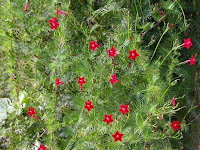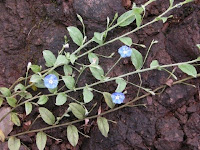FAMILY OF THE WEEK:CONVOLVULACEAE
19 views
Skip to first unread message
satish phadke
Jun 19, 2008, 10:58:51 AM6/19/08
to indiantreepix, wildflowerindia
CONVOLVULACEAE

Ipomoea carnea(Besharam)

Ipomoea quamoclit(Ganesh vel)

Evolvulus alsinoides(Vishnukrant)
Argyria cuneata
FAMILY OF THE WEEK : CONVOLVULACEAE
In India about 20 genera and 158 species occuring chiefly in southern and western India.
Vegetative characters:
Mostly herbs or shrubs often twining and very rarely trees.
The species of cuscuta are leafless and rootless total parasite with threadlike twinning stem which draws food material from host through suckers.
Sometimes as in Ipomoea batatas, the roots store great quantities of food and become thick and fleshy.The plants often contains latex.
The leaves are alternate,exstipulate,simple,sometimes pinnately(I.quamoquilt) or palmately(I.pes-tigridis) divided. In cuscuta the leaves are reduced to small scales.
Inflorescence and flowers:
The inflorescence is an axillary cyme or sometimes the flowers are solitary as in Calystegia.
The flowers are bracteate and the bracts are in pairs or sometimes forming an involucre as in Ipomoea pes-tigridis. They are often showy, perfect, bisexual,actinomorphic,pentamerous and hypogynous.
The calyx is deeply five lobed, persistent and sometimes enlarged in fruit. The corolla is gamopetalous, five lobed, campanulate,funnel shaped or subglobose.
The stamens are five epipetalous at the base. The anthers are oblong, diathecous, introrse and dehiscing longitudinally.
The gynoecium is bicarpellary and syncarpous with a superior ovary. The style is filiform and one but in Cuscuta there are two styles. The stigma is capitate, bilobed or two branched.
A ring like or cup shaped nectariferous disc present at the base of the ovary is often lobed.
Fruit is usually four or two valved capsule.The seeds are smooth or hairy.
Bright and showy flowers favor insect pollination.Funnel shaped flowers of Ipomoea are visited by nectar sucking birds.The seeds are dispersed by birds and animals.
Examples :
Ipomoea
Argyreia(Wooly morning glory)
Calonyction
Porana
--
SATISFIED http://satishphadke.blogspot.com/
Reply all
Reply to author
Forward
0 new messages
